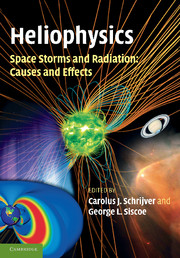Book contents
- Frontmatter
- Contents
- Preface
- 1 Perspective on heliophysics
- 2 Introduction to space storms and radiation
- 3 In-situ detection of energetic particles
- 4 Radiative signatures of energetic particles
- 5 Observations of solar and stellar eruptions, flares, and jets
- 6 Models of coronal mass ejections and flares
- 7 Shocks in heliophysics
- 8 Particle acceleration in shocks
- 9 Energetic particle transport
- 10 Energy conversion in planetary magnetospheres
- 11 Energization of trapped particles
- 12 Flares, coronal mass ejections, and atmospheric responses
- 13 Energetic particles and manned spaceflight
- 14 Energetic particles and technology
- Appendix I Authors and editors
- List of illustrations
- List of tables
- References
- Index
- Plate section
11 - Energization of trapped particles
Published online by Cambridge University Press: 05 April 2013
- Frontmatter
- Contents
- Preface
- 1 Perspective on heliophysics
- 2 Introduction to space storms and radiation
- 3 In-situ detection of energetic particles
- 4 Radiative signatures of energetic particles
- 5 Observations of solar and stellar eruptions, flares, and jets
- 6 Models of coronal mass ejections and flares
- 7 Shocks in heliophysics
- 8 Particle acceleration in shocks
- 9 Energetic particle transport
- 10 Energy conversion in planetary magnetospheres
- 11 Energization of trapped particles
- 12 Flares, coronal mass ejections, and atmospheric responses
- 13 Energetic particles and manned spaceflight
- 14 Energetic particles and technology
- Appendix I Authors and editors
- List of illustrations
- List of tables
- References
- Index
- Plate section
Summary
Heliophysical particles: universal processes and problems
At the time the very first satellites were launched half a century ago, the space environment was portrayed by mainstream media as the science fiction home where Flash Gordon fought evil aliens. The very real threat of Earth's radiation belts was not even imagined in either the fantasy or science worlds so no consideration was given to how the very energetic particles of the belts, traveling near the speed of light and capable of penetrating solid material, might affect instrumentation. Yet it was the diminished performance of the Geiger counter designed by James Van Allen (Van Allen et al., 1958; see also Section 3.1), that led to the eventual discovery of the belts. Van Allen speculated that the unusually low flux measurements returned by his experiment were actually a sign that the instrument had saturated, overwhelmed by a previously unknown and very large population of energetic particles.
The conjecture was confirmed by the dozens of satellites launched to probe Earth's magnetosphere providing a qualitative depiction and understanding of the radiation belts. (For a list of satellites with radiation belt particle data visit the Virtual Radiation Belt Observatory on line.) The belts consist of protons and electrons trapped in Earth's magnetic field forming torus-shaped regions extending from ˜1.5 to ˜10 Earth radii (RE) (see Fig. 11.1). The protons form only a single belt. The electrons form two belts separated at ˜2.5 RE by a minimum flux region known as the slot (Lyons and Thorne, 1973).
- Type
- Chapter
- Information
- Heliophysics: Space Storms and Radiation: Causes and Effects , pp. 293 - 320Publisher: Cambridge University PressPrint publication year: 2010

